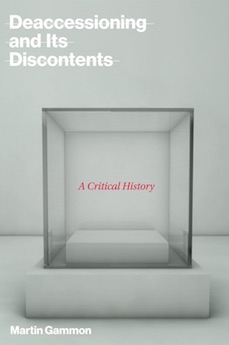By Svetlana Alpers
This is a heavy book both literally and figuratively. The literal weight of the chosen stock makes it hard to hold in the hands to read (odd for MIT whose books are normally elegant) and the writing often makes it heavy going to read.
But the subject is of great interest. Deaccessioning seems these days a common word. Though the practice has a long history, the interest is that the first use of the word was as recently as the 1970s.
As an art historian, in the days way before the internet brought art to the desktop, it was my practice to travel to a museum to look at a particular old master picture that was of interest to me. Usually, I had a catalogue of the museum, knew what I was looking for, and trusted that I would find it there. From the scholar’s point of view, the museum is a custodian, and the curatorial staff are students of the art in the collection. Disposing of a painting, which is what I thought deaccessioning to be, was neither useful nor proper.
Martin Gammon is a man who has worked in the art trade (the jacket flap mentions his employment by the British auctioneer Bonham’s in America, a founder of the Pergamon Art Group, and his appearance on PBS Antiques Road Show). His view of art is of something in circulation between private owners (where, leaving out the artist, in his view most of it begins), museums (which he chooses to refer to as the museum experiment because their assumption is Utopian), and the art trade broadly construed. His hope is that the circulation will be transparent to all. He wants to dispel what he refers to as deaccession apology and deaccession denial. The case histories which make up his book throw light on the practice as it has been conducted in the past.
The focus is on Britain and America. But because of differing national attitudes and policies, the greater part of the book concerns America. Gammon makes an interesting distinction between art in America as a public trust, in Britain as public benefit—the museum in Britain being comparable in its sense of its holdings to a library. Surplusage —or redundancy—is the concern about a collection in Britain, though in actual fact deaccession there has targeted big ticket works. Still, in attitude is it not the old world where art is an established cultural value versus the new world feeding off fresh capital and using it to move forward?
Gammon, in his fascinating observation of the goings-on of American museums, is a new world man. The case studies he presents in the book are extraordinary. Take Philadelphia, for example: in 1892 the Wilstachs bequeathed more than 190 works to serve as the nucleus for an art museum. By 1954, 80 percent of them had been deaccessioned, and the name is no longer remembered. Then we have the case of how the Met in New York managed to purchase Velázquez’s great portrait of his assistant Juan de Pareja. It was a moment when community activists in New York were calling for the de-centralization of the Met. Over protests, the museum de-accessioned important paintings and cleverly played what might be called the race card. Juan de Pareja, they pointed out, was a slave, of African descent with Hispanic heritage. Hoving, the director, held the winning hand.
Continuing at the Met, Gammon goes on to focus on what he calls “blaming the object,” which the Met did to in order to deaccession Jan van der Heyden’s Street in Delft given the museum in the De Groot bequest. (On page 219 he refers to van der Heyden’s A Street in Delft in the De Groot bequest at the Met, but under the image of the painting in his book after it eventually ends up at the Guildhall Art Gallery, City of London, it is titled View of the Boterbrug with the Tower of the Stadhuis, Delft, Holland.) The moral to this story is that the Van der Heyden deaccessioned on false grounds by the Met is now in the collection of the City of London.
So it goes. In this upbeat account art is not lost, it just circulates around be the reasons good or bad, justified or not. Appendices at the end offer detailed inventories of deaccessioning actions dealt with in a book that leaves one with a lot to ponder.
Reviewer Svetlana Alpers, an artist, critic, and renowned art historian, is professor emerita of the history of art at the University of California, Berkeley and a visiting scholar in the Department of Fine Arts at New York University.




